Get free scan and check if your device is infected.
Remove it nowTo use full-featured product, you have to purchase a license for Combo Cleaner. Seven days free trial available. Combo Cleaner is owned and operated by RCS LT, the parent company of PCRisk.com.
What kind of malware is Gycc?
Gycc, a ransomware strain, has been identified during the analysis of malware samples submitted to VirusTotal. Additionally, it has been established that Gycc is linked to the Djvu malware family. This particular ransomware variant functions by encrypting files, adding the ".gycc" extension to file names, and leaving a ransom note ("_readme.txt").
Illustrating its filename modification behavior, Gycc transforms "1.jpg" into "1.jpg.gycc", "2.png" into "2.png.gycc", and so forth. Due to its affiliation with the Djvu family, there is a significant probability that cybercriminals distribute Gycc in tandem with information stealers such as Vidar or RedLine.
Screenshot of files encrypted by Gycc ransomware:
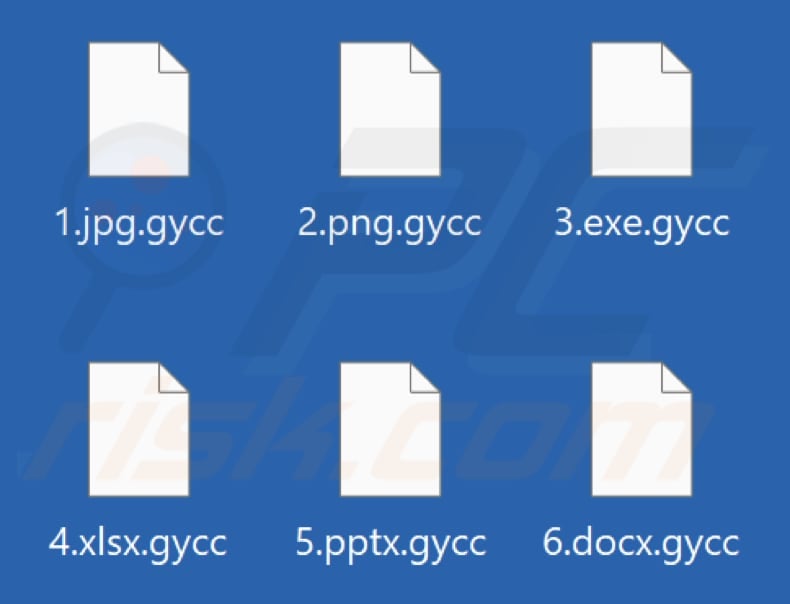
Gycc ransom note overview
The ransom note asserts that various files, spanning images, databases, and crucial documents, have undergone encryption. In order to regain access to these files, victims are directed to obtain a decryption tool and a unique key. The note offers reassurance by permitting victims to submit one encrypted file for complimentary decryption, provided the file lacks valuable information.
The cost associated with obtaining the private key and decryption software is set at $980. However, an opportunity for a 50% discount is presented if victims initiate contact with the attackers within the initial 72 hours, effectively reducing the price to $490. Victims can establish communication with the cybercriminals using the provided email addresses, namely support@freshmail.top, and datarestorehelp@airmail.cc.
More about ransomware
Deciphering files independently poses a substantial challenge as the attackers maintain control over the necessary decryption tools. This circumstance leaves victims with restricted options for restoring file accessibility. Two primary strategies for file recovery without yielding to ransom demands include relying on pre-existing backups or exploring potential third-party decryption solutions available on the internet.
It is not recommended to pay a ransom due to the absence of any guarantee that the attackers will fulfill their promises and provide the pledged decryption tools. Furthermore, succumbing to their demands inadvertently supports their illicit activities, potentially emboldening them to carry out more attacks.
It is crucial to acknowledge that ransomware possesses the capability to persist in encrypting files and may extend its reach to other computers within the local network. This underscores the critical necessity for prompt threat isolation and elimination.
Ransomware in general
In summary, ransomware represents a complex and ever-evolving threat within the realm of cybersecurity. Its manifestations vary from classic file encryption accompanied by ransom demands to contemporary tactics such as double extortion, where the attackers threaten to disclose sensitive data.
Some attacks try to catch victims broadly, while others focus on specific organizations. Despite these differences, the main goal is always malicious: to disrupt, extort, and make profits at the expense of individuals and businesses.
Examples of different ransomware variants are C3RB3R, GoTiS, and Zombi.
How did ransomware infect my computer?
Users frequently expose their computers to Djvu ransomware via websites claiming to offer video downloads from platforms like YouTube or pirated software, key generators and cracking tools, and links or attachments in emails designed to spread malware.
Moreover, cybercriminals use malicious advertisements, P2P networks, third-party downloaders, software vulnerabilities, Trojans, and similar channels to disseminate ransomware. Their goal usually involves luring users into downloading and activating ransomware by persuading them to take specific actions, such as enabling macro commands within malicious MS Office documents.
| Name | Gycc virus |
| Threat Type | Ransomware, Crypto Virus, Files locker |
| Encrypted Files Extension | .gycc |
| Ransom Demanding Message | _readme.txt |
| Free Decryptor Available? | Partial (more information below). |
| Ransom Amount | $490/$980 |
| Cyber Criminal Contact | support@freshmail.top, datarestorehelp@airmail.cc |
| Detection Names | Avast (PWSX-gen [Trj]), Bkav Pro (W32.AIDetectMalware), ESET-NOD32 (A Variant Of Win32/Kryptik.HVJG), Kaspersky (UDS:Trojan-Ransom.Win32.Stop.gen), Microsoft (Trojan:Win32/Sabsik.FL.B!ml), Full List Of Detections (VirusTotal) |
| Symptoms | Cannot open files stored on your computer, previously functional files now have a different extension (for example, my.docx.locked). A ransom demand message is displayed on your desktop. Cyber criminals demand payment of a ransom (usually in bitcoins) to unlock your files. |
| Distribution methods | Infected email attachments (macros), torrent websites, malicious ads, pirated software, cracking tools, pages offering to download videos from YouTube, etc. |
| Damage | All files are encrypted and cannot be opened without paying a ransom. Additional password-stealing trojans and malware infections can be installed together with a ransomware infection. |
| Malware Removal (Windows) |
To eliminate possible malware infections, scan your computer with legitimate antivirus software. Our security researchers recommend using Combo Cleaner. Download Combo CleanerTo use full-featured product, you have to purchase a license for Combo Cleaner. 7 days free trial available. Combo Cleaner is owned and operated by RCS LT, the parent company of PCRisk.com. |
How to protect yourself from ransomware infections?
Begin by ensuring your operating system and all software are regularly updated to address known vulnerabilities exploited by cybercriminals. Enhance your protection by installing reliable antivirus and anti-malware software. Exercise prudence when downloading files and clicking on links, especially in unexpected emails from unfamiliar or suspicious sources.
Avoid using pirated software or unofficial tools (e.g., key generators or cracking tools) to activate paid software. Foster safe browsing habits, steering clear of risky websites and refraining from clicking on pop-ups while visiting suspicious sites. If your computer is already infected with Gycc, we recommend running a scan with Combo Cleaner Antivirus for Windows to automatically eliminate this ransomware.
Screenshot of Gycc's text file ("_readme.txt"):
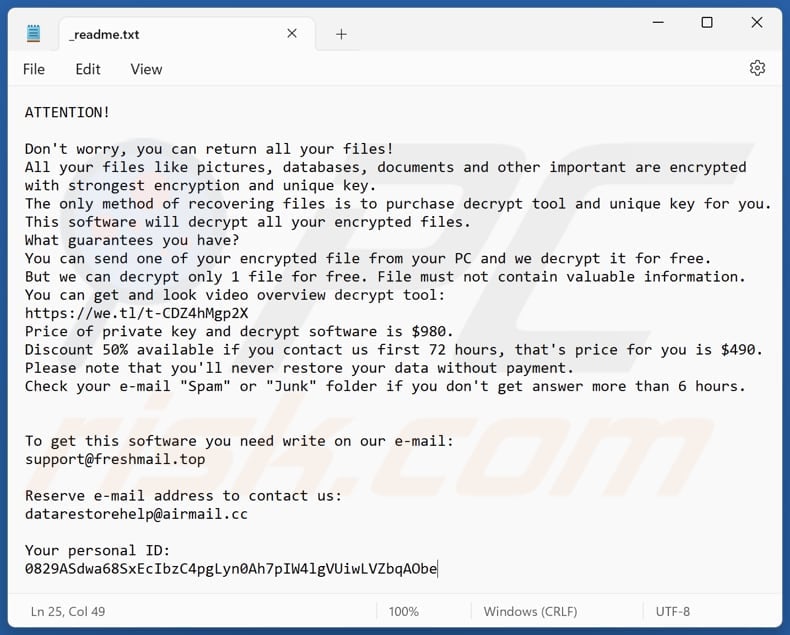
Text in the ransom note:
ATTENTION!
Don't worry, you can return all your files!
All your files like pictures, databases, documents and other important are encrypted with strongest encryption and unique key.
The only method of recovering files is to purchase decrypt tool and unique key for you.
This software will decrypt all your encrypted files.
What guarantees you have?
You can send one of your encrypted file from your PC and we decrypt it for free.
But we can decrypt only 1 file for free. File must not contain valuable information.
You can get and look video overview decrypt tool:
hxxps://we.tl/t-CDZ4hMgp2X
Price of private key and decrypt software is $980.
Discount 50% available if you contact us first 72 hours, that's price for you is $490.
Please note that you'll never restore your data without payment.
Check your e-mail "Spam" or "Junk" folder if you don't get answer more than 6 hours.
To get this software you need write on our e-mail:
support@freshmail.topReserve e-mail address to contact us:
datarestorehelp@airmail.ccYour personal ID:
-
There are currently two versions of Djvu ransomware infections: old and new. The old versions were designed to encrypt data by using a hard-coded "offline key" whenever the infected machine had no internet connection or the server was timing out/not responding.
Therefore, some victims were able to decrypt data using a tool developed by cyber security researcher, Michael Gillespie, however, since the encryption mechanism has been slightly changed (hence the new version, released in August, 2019), the decrypter no longer works and it is not supported anymore.
If your data has been encrypted by an older version, you might be able to restore it with the another tool developed by Emsisoft and Michael Gillespie. It supports a total of 148 Djvu's variants and you can find more information, as well as download link and decryption instructions in Emsisoft's official page.
Screenshot of Djvu decryption tool by Emsisoft and Michael Gillespie:
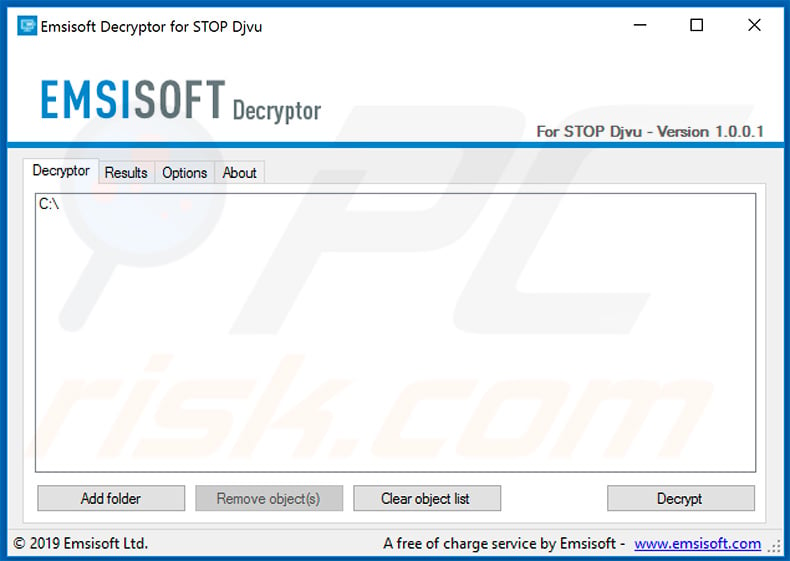
Additionally, Emsisoft is now providing a service that allows to decrypt data (again, only if it was encrypted by Djvu variants released before August, 2019) for those victims who have a pair of the same file before and after the encryption. All victims have to do is upload a pair of original and encrypted file to Emsisoft's Djvu decryption page and download the aforementioned decryption tool (the download link will be provided after uploading files).
Note that the file processing may take some time so be patient. It is also worth mentioning that the system must have an Internet connection during the entire decryption process, otherwise it will fail.
Screenshot of Emsisoft's Djvu decryption service page:
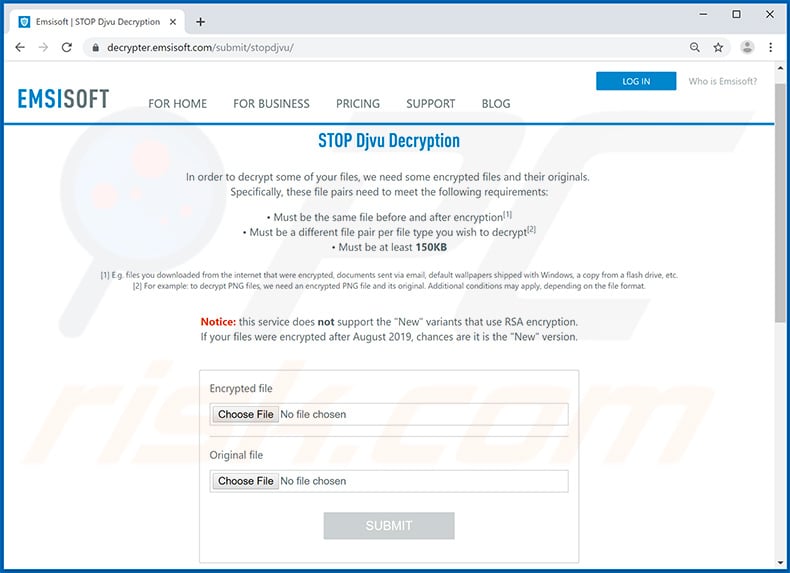
Some victims state that they've successfully restored a part of encrypted data using PhotoRec tool developed by CGSecurity (Christophe Grenier). You can download this tool from CGSecurity's official website.
Screenshot of PhotoRec application:
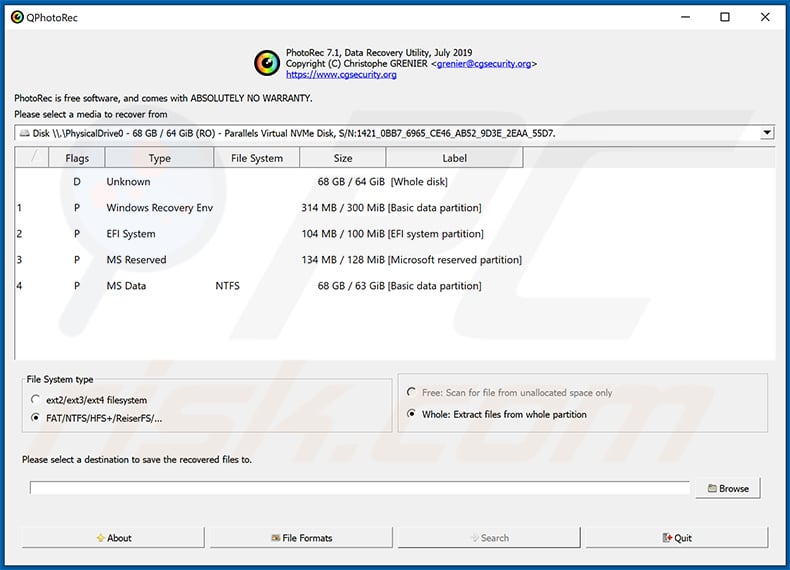
Now it is worth noting that Djvu ransomware does not encrypt the entire file. Instead, it encrypts only a portion (start) of the file, thereby making it unusable. Luckily, in some cases it is possible to restore other part of the file, which is not encrypted. This is useful when it comes to audio/video files, because even though the start won't be restored, you'll still be able to use most of it.
To restore audio/video data we advise you to use Media_Repair tool developed by DiskTuna. This tool is extremely simple and completely free. You can find the user manual as well as download the tool directly from DiskTuna's website.
Screenshot of Media_Repair application developed by DiskTuna:
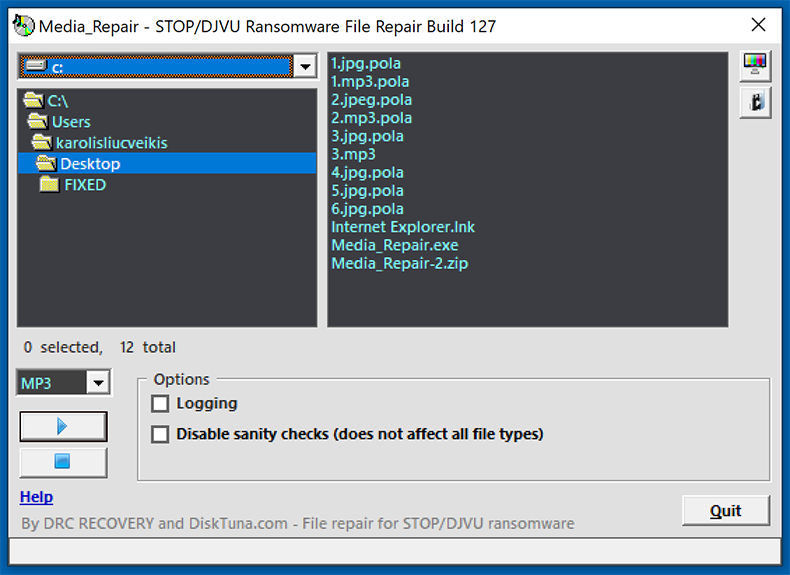
G DATA company has also released a "vaccine" capable of preventing Djvu ransomware from encrypting data. This does not mean that the malware won't be able to enter the system or to perform other actions (e.g., change system settings). However, the encryption will be prevented nevertheless. You can download the vaccination tool from this GitHub page.
Screenshot of G DATA's Djvu ransomware vaccination tool:
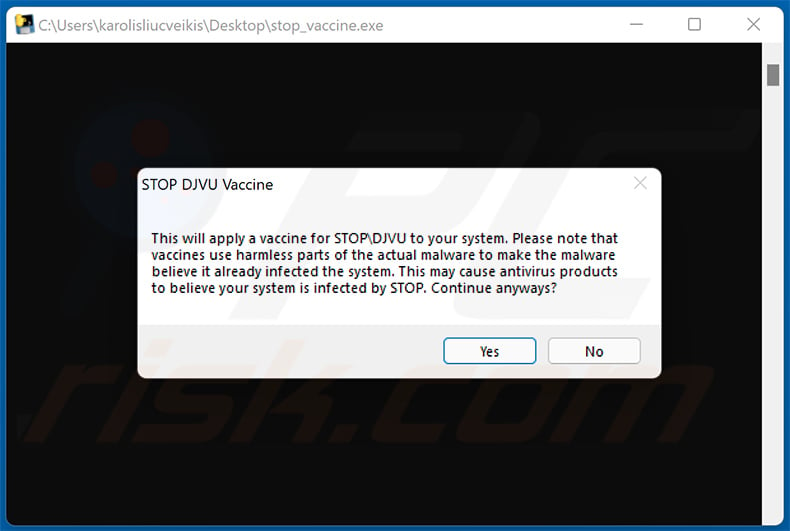
Video showing how to remove Gycc ransomware using Combo Cleaner:
Gycc ransomware removal:
Instant automatic malware removal:
Manual threat removal might be a lengthy and complicated process that requires advanced IT skills. Combo Cleaner is a professional automatic malware removal tool that is recommended to get rid of malware. Download it by clicking the button below:
DOWNLOAD Combo CleanerBy downloading any software listed on this website you agree to our Privacy Policy and Terms of Use. To use full-featured product, you have to purchase a license for Combo Cleaner. 7 days free trial available. Combo Cleaner is owned and operated by RCS LT, the parent company of PCRisk.com.
Video suggesting what steps should be taken in case of a ransomware infection:
Quick menu:
- What is Gycc virus?
- STEP 1. Reporting ransomware to authorities.
- STEP 2. Isolating the infected device.
- STEP 3. Identifying the ransomware infection.
- STEP 4. Searching for ransomware decryption tools.
- STEP 5. Restoring files with data recovery tools.
- STEP 6. Creating data backups.
If you are a victim of a ransomware attack we recommend reporting this incident to authorities. By providing information to law enforcement agencies you will help track cybercrime and potentially assist in the prosecution of the attackers. Here's a list of authorities where you should report a ransomware attack. For the complete list of local cybersecurity centers and information on why you should report ransomware attacks, read this article.
List of local authorities where ransomware attacks should be reported (choose one depending on your residence address):
USA - Internet Crime Complaint Centre IC3
United Kingdom - Action Fraud
Spain - Policía Nacional
France - Ministère de l'Intérieur
Germany - Polizei
Italy - Polizia di Stato
The Netherlands - Politie
Poland - Policja
Portugal - Polícia Judiciária
Isolating the infected device:
Some ransomware-type infections are designed to encrypt files within external storage devices, infect them, and even spread throughout the entire local network. For this reason, it is very important to isolate the infected device (computer) as soon as possible.
Step 1: Disconnect from the internet.
The easiest way to disconnect a computer from the internet is to unplug the Ethernet cable from the motherboard, however, some devices are connected via a wireless network and for some users (especially those who are not particularly tech-savvy), disconnecting cables may seem troublesome. Therefore, you can also disconnect the system manually via Control Panel:
Navigate to the "Control Panel", click the search bar in the upper-right corner of the screen, enter "Network and Sharing Center" and select search result: 
Click the "Change adapter settings" option in the upper-left corner of the window: 
Right-click on each connection point and select "Disable". Once disabled, the system will no longer be connected to the internet. To re-enable the connection points, simply right-click again and select "Enable". 
Step 2: Unplug all storage devices.
As mentioned above, ransomware might encrypt data and infiltrate all storage devices that are connected to the computer. For this reason, all external storage devices (flash drives, portable hard drives, etc.) should be disconnected immediately, however, we strongly advise you to eject each device before disconnecting to prevent data corruption:
Navigate to "My Computer", right-click on each connected device, and select "Eject": 
Step 3: Log-out of cloud storage accounts.
Some ransomware-type might be able to hijack software that handles data stored within "the Cloud". Therefore, the data could be corrupted/encrypted. For this reason, you should log-out of all cloud storage accounts within browsers and other related software. You should also consider temporarily uninstalling the cloud-management software until the infection is completely removed.
Identify the ransomware infection:
To properly handle an infection, one must first identify it. Some ransomware infections use ransom-demand messages as an introduction (see the WALDO ransomware text file below).

This, however, is rare. In most cases, ransomware infections deliver more direct messages simply stating that data is encrypted and that victims must pay some sort of ransom. Note that ransomware-type infections typically generate messages with different file names (for example, "_readme.txt", "READ-ME.txt", "DECRYPTION_INSTRUCTIONS.txt", "DECRYPT_FILES.html", etc.). Therefore, using the name of a ransom message may seem like a good way to identify the infection. The problem is that most of these names are generic and some infections use the same names, even though the delivered messages are different and the infections themselves are unrelated. Therefore, using the message filename alone can be ineffective and even lead to permanent data loss (for example, by attempting to decrypt data using tools designed for different ransomware infections, users are likely to end up permanently damaging files and decryption will no longer be possible even with the correct tool).
Another way to identify a ransomware infection is to check the file extension, which is appended to each encrypted file. Ransomware infections are often named by the extensions they append (see files encrypted by Qewe ransomware below).

This method is only effective, however, when the appended extension is unique - many ransomware infections append a generic extension (for example, ".encrypted", ".enc", ".crypted", ".locked", etc.). In these cases, identifying ransomware by its appended extension becomes impossible.
One of the easiest and quickest ways to identify a ransomware infection is to use the ID Ransomware website. This service supports most existing ransomware infections. Victims simply upload a ransom message and/or one encrypted file (we advise you to upload both if possible).

The ransomware will be identified within seconds and you will be provided with various details, such as the name of the malware family to which the infection belongs, whether it is decryptable, and so on.
Example 1 (Qewe [Stop/Djvu] ransomware):

Example 2 (.iso [Phobos] ransomware):

If your data happens to be encrypted by ransomware that is not supported by ID Ransomware, you can always try searching the internet by using certain keywords (for example, a ransom message title, file extension, provided contact emails, crypto wallet addresses, etc.).
Search for ransomware decryption tools:
Encryption algorithms used by most ransomware-type infections are extremely sophisticated and, if the encryption is performed properly, only the developer is capable of restoring data. This is because decryption requires a specific key, which is generated during the encryption. Restoring data without the key is impossible. In most cases, cybercriminals store keys on a remote server, rather than using the infected machine as a host. Dharma (CrySis), Phobos, and other families of high-end ransomware infections are virtually flawless, and thus restoring data encrypted without the developers' involvement is simply impossible. Despite this, there are dozens of ransomware-type infections that are poorly developed and contain a number of flaws (for example, the use of identical encryption/decryption keys for each victim, keys stored locally, etc.). Therefore, always check for available decryption tools for any ransomware that infiltrates your computer.
Finding the correct decryption tool on the internet can be very frustrating. For this reason, we recommend that you use the No More Ransom Project and this is where identifying the ransomware infection is useful. The No More Ransom Project website contains a "Decryption Tools" section with a search bar. Enter the name of the identified ransomware, and all available decryptors (if there are any) will be listed.

Restore files with data recovery tools:
Depending on the situation (quality of ransomware infection, type of encryption algorithm used, etc.), restoring data with certain third-party tools might be possible. Therefore, we advise you to use the Recuva tool developed by CCleaner. This tool supports over a thousand data types (graphics, video, audio, documents, etc.) and it is very intuitive (little knowledge is necessary to recover data). In addition, the recovery feature is completely free.
Step 1: Perform a scan.
Run the Recuva application and follow the wizard. You will be prompted with several windows allowing you to choose what file types to look for, which locations should be scanned, etc. All you need to do is select the options you're looking for and start the scan. We advise you to enable the "Deep Scan" before starting, otherwise, the application's scanning capabilities will be restricted.

Wait for Recuva to complete the scan. The scanning duration depends on the volume of files (both in quantity and size) that you are scanning (for example, several hundred gigabytes could take over an hour to scan). Therefore, be patient during the scanning process. We also advise against modifying or deleting existing files, since this might interfere with the scan. If you add additional data (for example, downloading files/content) while scanning, this will prolong the process:

Step 2: Recover data.
Once the process is complete, select the folders/files you wish to restore and simply click "Recover". Note that some free space on your storage drive is necessary to restore data:

Create data backups:
Proper file management and creating backups is essential for data security. Therefore, always be very careful and think ahead.
Partition management: We recommend that you store your data in multiple partitions and avoid storing important files within the partition that contains the entire operating system. If you fall into a situation whereby you cannot boot the system and are forced to format the disk on which the operating system is installed (in most cases, this is where malware infections hide), you will lose all data stored within that drive. This is the advantage of having multiple partitions: if you have the entire storage device assigned to a single partition, you will be forced to delete everything, however, creating multiple partitions and allocating the data properly allows you to prevent such problems. You can easily format a single partition without affecting the others - therefore, one will be cleaned and the others will remain untouched, and your data will be saved. Managing partitions is quite simple and you can find all the necessary information on Microsoft's documentation web page.
Data backups: One of the most reliable backup methods is to use an external storage device and keep it unplugged. Copy your data to an external hard drive, flash (thumb) drive, SSD, HDD, or any other storage device, unplug it and store it in a dry place away from the sun and extreme temperatures. This method is, however, quite inefficient, since data backups and updates need to be made regularly. You can also use a cloud service or remote server. Here, an internet connection is required and there is always the chance of a security breach, although it's a really rare occasion.
We recommend using Microsoft OneDrive for backing up your files. OneDrive lets you store your personal files and data in the cloud, sync files across computers and mobile devices, allowing you to access and edit your files from all of your Windows devices. OneDrive lets you save, share and preview files, access download history, move, delete, and rename files, as well as create new folders, and much more.
You can back up your most important folders and files on your PC (your Desktop, Documents, and Pictures folders). Some of OneDrive’s more notable features include file versioning, which keeps older versions of files for up to 30 days. OneDrive features a recycling bin in which all of your deleted files are stored for a limited time. Deleted files are not counted as part of the user’s allocation.
The service is built using HTML5 technologies and allows you to upload files up to 300 MB via drag and drop into the web browser or up to 10 GB via the OneDrive desktop application. With OneDrive, you can download entire folders as a single ZIP file with up to 10,000 files, although it can’t exceed 15 GB per single download.
OneDrive comes with 5 GB of free storage out of the box, with an additional 100 GB, 1 TB, and 6 TB storage options available for a subscription-based fee. You can get one of these storage plans by either purchasing additional storage separately or with Office 365 subscription.
Creating a data backup:
The backup process is the same for all file types and folders. Here’s how you can back up your files using Microsoft OneDrive
Step 1: Choose the files/folders you want to backup.

Click the OneDrive cloud icon to open the OneDrive menu. While in this menu, you can customize your file backup settings.

Click Help & Settings and then select Settings from the drop-down menu.

Go to the Backup tab and click Manage backup.

In this menu, you can choose to backup the Desktop and all of the files on it, and Documents and Pictures folders, again, with all of the files in them. Click Start backup.
Now, when you add a file or folder in the Desktop and Documents and Pictures folders, they will be automatically backed up on OneDrive.
To add folders and files, not in the locations shown above, you have to add them manually.

Open File Explorer and navigate to the location of the folder/file you want to backup. Select the item, right-click it, and click Copy.

Then, navigate to OneDrive, right-click anywhere in the window and click Paste. Alternatively, you can just drag and drop a file into OneDrive. OneDrive will automatically create a backup of the folder/file.

All of the files added to the OneDrive folder are backed up in the cloud automatically. The green circle with the checkmark in it indicates that the file is available both locally and on OneDrive and that the file version is the same on both. The blue cloud icon indicates that the file has not been synced and is available only on OneDrive. The sync icon indicates that the file is currently syncing.

To access files only located on OneDrive online, go to the Help & Settings drop-down menu and select View online.

Step 2: Restore corrupted files.
OneDrive makes sure that the files stay in sync, so the version of the file on the computer is the same version on the cloud. However, if ransomware has encrypted your files, you can take advantage of OneDrive’s Version history feature that will allow you to restore the file versions prior to encryption.
Microsoft 365 has a ransomware detection feature that notifies you when your OneDrive files have been attacked and guide you through the process of restoring your files. It must be noted, however, that if you don’t have a paid Microsoft 365 subscription, you only get one detection and file recovery for free.
If your OneDrive files get deleted, corrupted, or infected by malware, you can restore your entire OneDrive to a previous state. Here’s how you can restore your entire OneDrive:

1. If you're signed in with a personal account, click the Settings cog at the top of the page. Then, click Options and select Restore your OneDrive.
If you're signed in with a work or school account, click the Settings cog at the top of the page. Then, click Restore your OneDrive.
2. On the Restore your OneDrive page, select a date from the drop-down list. Note that if you're restoring your files after automatic ransomware detection, a restore date will be selected for you.
3. After configuring all of the file restoration options, click Restore to undo all the activities you selected.
The best way to avoid damage from ransomware infections is to maintain regular up-to-date backups.
Frequently Asked Questions (FAQ)
How was my computer hacked and how did hackers encrypt my files?
Ransomware distribution takes diverse forms, including the use of files or links embedded in emails, malicious advertisements, drive-by downloads, and peer-to-peer (P2P) networks. Specifically, in the case of Djvu ransomware, cybercriminals leverage cracked software distribution platforms and deceptive websites posing as platforms for downloading YouTube videos. Through these deceptive tactics, users are misled into unwittingly compromising the security of their computers.
How to open ".gycc" files?
Your files have been encrypted as a result of a ransomware attack. In order to restore access and resume using your files, a decryption process is required.
How can I decrypt ".gycc" files for free?
Djvu ransomware commonly employs an online key for file encryption, rendering free decryption unfeasible without the intervention of the developers or distributors. In exceptional cases, data might be encrypted using an offline key, offering a possibility for data restoration through the use of Emsisoft's Djvu decryption software (more information above).
Should I pay a ransom?
Paying a ransom is not recommended as it contributes to the support of cybercriminals, and there is no guarantee of receiving decryption software or key in return.
Will Combo Cleaner help me remove Gycc ransomware?
Combo Cleaner can conduct a comprehensive scan of your computer and remove any active ransomware infections. It is important to emphasize that while employing an antivirus program serves as the initial measure in ransomware recovery, security software lacks the capability to decrypt files.
Share:

Tomas Meskauskas
Expert security researcher, professional malware analyst
I am passionate about computer security and technology. I have an experience of over 10 years working in various companies related to computer technical issue solving and Internet security. I have been working as an author and editor for pcrisk.com since 2010. Follow me on Twitter and LinkedIn to stay informed about the latest online security threats.
PCrisk security portal is brought by a company RCS LT.
Joined forces of security researchers help educate computer users about the latest online security threats. More information about the company RCS LT.
Our malware removal guides are free. However, if you want to support us you can send us a donation.
DonatePCrisk security portal is brought by a company RCS LT.
Joined forces of security researchers help educate computer users about the latest online security threats. More information about the company RCS LT.
Our malware removal guides are free. However, if you want to support us you can send us a donation.
Donate
▼ Show Discussion